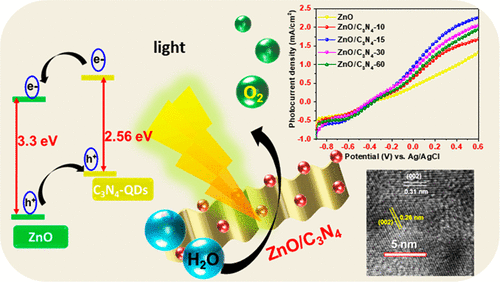当前位置:
X-MOL 学术
›
ACS Appl. Nano Mater.
›
论文详情
Our official English website, www.x-mol.net, welcomes your
feedback! (Note: you will need to create a separate account there.)
ZnO Nanosheets Decorated with Graphite-Like Carbon Nitride Quantum Dots as Photoanodes in Photoelectrochemical Water Splitting
ACS Applied Nano Materials ( IF 5.3 ) Pub Date : 2020-01-27 , DOI: 10.1021/acsanm.0c00081 Chavi Mahala 1 , Mamta Devi Sharma 1 , Mrinmoyee Basu 1
ACS Applied Nano Materials ( IF 5.3 ) Pub Date : 2020-01-27 , DOI: 10.1021/acsanm.0c00081 Chavi Mahala 1 , Mamta Devi Sharma 1 , Mrinmoyee Basu 1
Affiliation

|
The efficient utilization of solar power is becoming an important strategy for its conversion into a storable, clean, and renewable energy source like H2. To generate H2 as a chemical fuel from solar power, attempts are being made to establish photoelectrochemical (PEC) water splitting as an efficient, greener pathway. Here, the surfaces of ZnO 2D nanosheets are adorned by graphite-like carbon nitride (g-C3N4) quantum dots (QDs) with the intention of developing efficient photoanodes. Sensitization of ZnO nanosheets with C3N4 QDs leads to a more enhanced PEC performance than that of bare ZnO. The observed enhancement in PEC is due to the high light absorbance and photon-generated charge-carrier separation. The best-obtained ZnO/C3N4 photoanode exhibits a nearly 2.29 times as high photocurrent density compared to bare ZnO. ZnO 2D sheets can generate a photocurrent density of 0.414 mA cm–2 at 0.5994 V versus reversible hydrogen electrode (RHE), whereas ZnO/C3N4 can produce 0.952 mA cm–2 at 0.5994 V versus RHE under uninterrupted conditions of light illumination. Further, there is improvement in the observed PEC activity of the heterostructure because of enhancement in the carrier density. The carrier density enhances nearly 2.2 times in the heterostructure compared to the bare ZnO sheet. ZnO/C3N4 shows a maximum photoconversion efficiency (η) of 0.70%. Both ZnO 2D sheets and the ZnO/C3N4 heterostructure show efficient stability under chopped irradiation of light for 1000 s. The stability of ZnO/C3N4 is also determined for 1 h under continuous illumination.
中文翻译:

ZnO纳米片修饰的类似石墨的氮化碳量子点作为光电化学水分解中的光阳极
太阳能的有效利用正成为将其转换为可存储,清洁和可再生能源(如H 2)的重要策略。为了从太阳能产生H 2作为化学燃料,人们正在尝试建立光电化学(PEC)水分解作为一种有效的绿色途径。在这里,ZnO 2D纳米片的表面用类石墨氮化碳(gC 3 N 4)量子点(QDs)装饰,目的是开发有效的光阳极。ZnO纳米片的C 3 N 4敏化QD导致的PEC性能比裸ZnO更好。观察到的PEC增强是由于高吸光度和光子产生的电荷-载流子分离。与裸露的ZnO相比,获得最佳的ZnO / C 3 N 4光电阳极具有近2.29倍的高光电流密度。相对于可逆氢电极(RHE),ZnO 2D薄片在0.5994 V时可产生0.414 mA cm –2的光电流密度,而ZnO / C 3 N 4可以产生0.952 mA cm –2的光电流密度在不间断的光照条件下,相对于RHE为0.5994V。此外,由于载流子密度的提高,观察到的异质结构的PEC活性得到改善。与裸露的ZnO薄片相比,异质结构中的载流子密度提高了近2.2倍。ZnO / C 3 N 4的最大光转换效率(η)为0.70%。ZnO 2D薄片和ZnO / C 3 N 4异质结构在短切光照射1000 s时均显示出有效的稳定性。ZnO / C 3 N 4的稳定性也要在连续光照下测定1小时。
更新日期:2020-01-29
中文翻译:

ZnO纳米片修饰的类似石墨的氮化碳量子点作为光电化学水分解中的光阳极
太阳能的有效利用正成为将其转换为可存储,清洁和可再生能源(如H 2)的重要策略。为了从太阳能产生H 2作为化学燃料,人们正在尝试建立光电化学(PEC)水分解作为一种有效的绿色途径。在这里,ZnO 2D纳米片的表面用类石墨氮化碳(gC 3 N 4)量子点(QDs)装饰,目的是开发有效的光阳极。ZnO纳米片的C 3 N 4敏化QD导致的PEC性能比裸ZnO更好。观察到的PEC增强是由于高吸光度和光子产生的电荷-载流子分离。与裸露的ZnO相比,获得最佳的ZnO / C 3 N 4光电阳极具有近2.29倍的高光电流密度。相对于可逆氢电极(RHE),ZnO 2D薄片在0.5994 V时可产生0.414 mA cm –2的光电流密度,而ZnO / C 3 N 4可以产生0.952 mA cm –2的光电流密度在不间断的光照条件下,相对于RHE为0.5994V。此外,由于载流子密度的提高,观察到的异质结构的PEC活性得到改善。与裸露的ZnO薄片相比,异质结构中的载流子密度提高了近2.2倍。ZnO / C 3 N 4的最大光转换效率(η)为0.70%。ZnO 2D薄片和ZnO / C 3 N 4异质结构在短切光照射1000 s时均显示出有效的稳定性。ZnO / C 3 N 4的稳定性也要在连续光照下测定1小时。











































 京公网安备 11010802027423号
京公网安备 11010802027423号